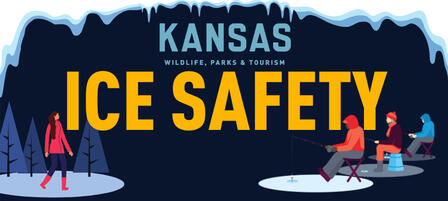KDWPT Provides Ice Safety Tips

PRATT – Frozen lakes can be tempting spots for late-winter goose hunters, anglers with an itch to ice fish, and park-goers looking to get some fresh air, but no matter how thick the ice layer, frozen waters should always be approached with caution.
While no ice is 100 percent safe, the Kansas Department of Wildlife, Parks and Tourism (KDWPT) shares these tips to ensure that outdoors enthusiasts return safely home after recreating near or on frozen waters.
The clearer, the better
The appearance of the ice can give potential clues to its integrity. New, clear ice is the strongest. White ice may only be about half as strong. Warm, sunny days can melt the surface and “honeycomb” the ice, which will weaken it, as well. Also be aware that temperature, snow cover, currents, springs and even roosting geese can affect the strength and safety of ice. Never take ice strength and thickness for granted.
Measure for thickness
Wait for at least 4 inches of clear, hard ice before walking on any ice-covered waterbody, and 5-7 inches of ice is necessary to support a snowmobile or all-terrain vehicle (ATV). It usually takes several days of calm weather with single-digit temperatures to make “safe” ice. Continually measure the ice thickness when moving farther from shore. And when in doubt, back away and remain on land.
Don’t go it alone
KDWPT recommends never recreating alone, especially during winter; invite a family member or friend. Should an incident occur, chances of survival may be increased with more people present.
If hunting or fishing, pack safety gear
Carry ice picks, and have a length of rope and a throwable floatation device for every member of your party. It’s also a good idea to wear ice cleats, as they make walking on smooth ice easier and much safer.
If fishing, keep ice holes small
When ice fishing, it’s best to use an auger to cut holes – this is a quick and efficient method for drilling into the ice. In Kansas, holes cut in the ice of public waters may be no more than 12 inches in diameter; though, this is a good practice for private waters, as well.
Vehicle use
Motorized electric or gasoline-powered ATVs, work-site utility vehicles, golf carts and snowmobiles may be operated on ice-covered department waters only for the purpose of ice fishing and only from one-half hour before sunrise to one-half hour after sunset. Vehicles shall enter onto the ice only from boat ramps and points of entry established by posted notice.
Falling into frigid water can be a deadly mistake as hypothermia can overcome a person within minutes. Follow these basic rules outlined above to ensure your wintertime outings remain safe and enjoyable.
For more ice safety tips, like and follow KDWPT on Facebook at www.facebook.com/kdwpt, or visit ksoutdoors.com.
-30-









